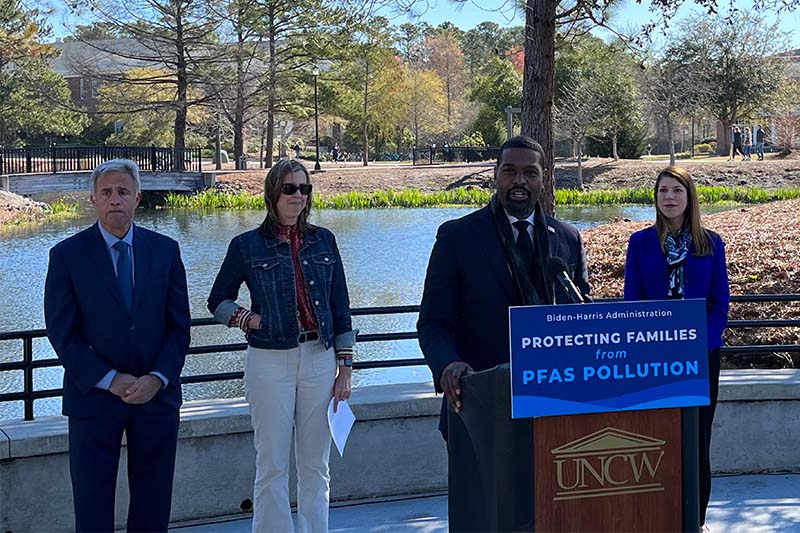On March 14th, 2023 the Environmental Protection Agency (EPA) proposed new drinking water regulations for six perfluoroalkyl and polyfluoroalkyl substances (PFAS) chemicals, the first such proposal for any PFAS. PFAS are human-made and have been manufactured and used in the United States for over 80 years to make a broad array of consumer and industrial products. They have been shown to be toxic, persistent, and bioaccumulative, which means they can build up over time in someone’s body. PFAS exposure through contaminated drinking water has been linked to several negative health outcomes, including various forms of cancer.
The Biden Administration’s PFAS Strategic Roadmap had previously indicated that proposed standards would be developed for PFOA (perfluorooctanoic acid) and PFOS (perfluorooctane sulfonic acid). However, EPA Administrator Michael Regan announced individual standards or limits of 4 ppt (parts per trillion) each for PFOA and PFOS, and the use of a combined hazard index to regulate four additional PFAS chemicals: HFPO (also known as GenX), PFNA, PFHxS, and PFBS. These proposed standards are a significant and long-awaited step to putting in place enforceable public health protections for PFAS, the broader class of chemicals commonly referred to as “forever chemicals.”

EPA Administrator Michael Regan speaks about proposed new drinking water regulations for six PFAS chemicals at a news conference on Tuesday, March 14, 2023. Image Credit: Matthew Prensky
As detailed in our earlier report on PFAS drinking water standards, “Parts per Trillion,” if finalized, they will represent the first new federal drinking water standards for any contaminant since 1996, when the current process for establishing such standards was enacted. To date, there has been no federal drinking water standard for any PFAS chemicals.
In this blog, we discuss how the regulations proposed on Tuesday came to be, the impact on standards established at the state level, and potential future developments for the regulation of PFAS chemicals.
How We Got to Today: PFAS Rulemaking
The rulemaking process for establishing federal drinking water standards is especially lengthy, but the pace of regulatory processes at both the state and federal level generally don’t align with the large universe of potential PFAS contaminants. PFOA and PFOS and the other four compounds under this newly proposed federal regulation are just a handful of the more than 9,000 (and growing) human-made PFAS compounds. Short of regulating more PFAS together as a group or class, it would likely take many lifetimes to address all PFAS compounds.
The formal pathway to regulation generally begins when potential contaminants are placed on the Contaminant Candidate List (CCL) based on their potential health impacts and how frequently they are known or anticipated to be found in water systems. PFOA and PFOS were first included on CCL 3 in 2009 and again on CCL 4 in 2016.
Contaminants from the CCL may then be selected for further evaluation and data collection through the Unregulated Contaminant Monitoring Rule (UCMR) process. This process includes the nationwide testing of drinking water systems to determine how frequently and at what levels a contaminant may occur in drinking water systems. PFOA and PFOS were included on the Third UCMR list in 2012, the testing for which was conducted between 2013 – 2015.
Based, in part, on the occurrence data collected through the UCMR process, a final determination was made to take further regulatory action to establish drinking water standards in 2021. This led to the proposed rule announced on March 14, 2023. The rule will now be subject to a public comment period before being finalized. The EPA noted that it anticipates that finalization by the end of 2023.
Until now, the EPA has issued health advisory levels (HALS) starting in 2009, and then again in 2016 and 2022. These levels are non-enforceable and act as guidance to states if and as they develop their own advisories or standards for short-term to lifetime exposures. In June 2022, the EPA issued interim updated drinking water health advisory levels (HALs) for PFOA and PFOS, at 0.004 ppt and 0.02 ppt, respectively—orders of magnitude lower than the previous advisories and existing state standards.
EPA PFAS Drinking Water Levels
| Date | Level Type | Compound | Limit (ppt) |
|---|---|---|---|
| 2009 | Health Advisory Level for short-term exposure | PFOA
PFOS |
400
200 |
| 2016 | Health Advisory Level for lifetime exposure | PFOA/PFOS combined | 70 |
| 2022 | Interim Health Advisory Levels | PFOA
PFOS PFBS HFPO (GenX) |
0.004 ppt
0.02 ppt 2,000 ppt 10 ppt |
| 2023 | Proposed Drinking Water Standard (MCL) | PFOA
PFOS Hazard Index including: HFPO (also known as GenX), PFNA, PFHxS and PFBS |
4 ppt
4 ppt 1.0 (unitless ratio) |
What Will Be the Impact on State Drinking Water Standards?
Since the EPA’s 2016 health advisory level of 70 ppt combined for PFOA and PFOS, several states have established enforceable regulatory standards for PFAS chemicals in drinking water. While all the current state standards are well below both the EPA’s 2009 and 2016 health advisory levels, the federal standards proposed on March 14, 2023, for PFOA and PFOS are lower than any of these existing state standards for individual PFAS. Once finalized, all states will be required to make their regulations at least as protective as those federal standards. The inclusion of six compounds in the proposed regulations, and the use of a hazard index to set a combined level for four of them mirrors regulatory approaches already observed at the state level. Our chemical regulatory systems have been dominated by a one-by-one approach which sets limits for compounds individually. In contrast, the use of a combined hazard index, which limits the levels of multiple co-occurring compounds at once, is one means to address the potential effects that toxic or hazardous chemicals may have when they are found together and interact with each other in a dynamic environment.
A number of factors contribute to the variation between the standards set by the states and the newly proposed federal standards. Regulations are developed considering a range of variables and different oversight bodies may make different choices for the variables in calculating standards. Variations across standards reflect those different choices of variables within the underlying calculations of the levels that are determined to be protective of public health impacts. This includes: which health impacts are considered; which vulnerable populations are deemed of most concern; how much of a person’s exposure to a contaminant is estimated to come from a particular source (referred to as the relative source contribution); and which uncertainty factors are applied to account for the degree to which we don’t know, lack data on, or are extrapolating data from one type of subject to another. In this case, the different choices have meant that the EPA’s health-based values and goals were orders of magnitude lower than state-level calculations.
In addition, “environmental standards do not only reflect health impacts but technological capacity and decisions about ensuring production.” That is, standards are not necessarily set at those health-based levels or the maximum contaminant level goal (MCLG). There is sometimes (even often) a gap between those lower health-based values and goals, and the resultant standard. In the case of the new EPA proposal, this gap is reflected in the difference between the MCLG of 0 ppt for PFOA and PFOS, and the proposed standard of 4 ppt each. This difference has been driven by technological limits. The EPA has previously determined the lowest level at which most labs across the country can reliably test down PFOA and PFOS is 4 ppt.
… the federal standards proposed on March 14, 2023, for PFOA and PFOS are lower than any of these existing state standards for individual PFAS.
Testing and occurrence data in New York, in particular, has reflected that drinking water systems across the state have levels of PFAS that exceed the EPA’s newly proposed standards. New York State first established drinking water standards for PFOA and PFOS in August 2020 at 10 ppt each. More recently, in the fall of 2022, New York State’s Department of Health (DOH) proposed draft regulations for a combined standard of 30 ppt for six PFAS (PFNA, PFHxS, PFHpA, PFDA, PFOA, and PFOS) and individual standards of 10 ppt each for PFHxS, PFNA, PFHpA, and PFDA following recommendations from the agency’s Drinking Water Quality Council.
At the same time, DOH proposed adding notification levels (NLs) for GenX at 10 ppt and 19 other PFAS compounds at two different combined levels. NLs are not enforceable standards but compel water systems to alert authorities and/or residents. This included a combined NL of 30 ppt for six PFAS (PFHpS, PFUnA, PFDoA, GenX, 9Cl-PF3ONS, and 11Cl-PF3OUdS) and a combined NL of 100 ppt for 13 PFAS (PFBA, PFBS, PFPeA, PFPeS, PFHxA, ADONA, 4:2FTS, 6:2FTS, 8:2FTS, NFDHA, PFEESA, PFMPA, PFMBA). These proposed standards and notification levels were followed by a 60-day comment period and had a slated effective date of April 1, 2023—though they’ve not yet been adopted.
Just as we noted when the EPA issued its revised health advisory levels in 2022, given the more closely health-aligned levels at which the agency has now proposed federal standards, “existing state standards should be reconsidered” and many states have indeed already noted that “state standards may be subject to further review.”
Is This Just the Beginning?
Further PFAS compounds were included on the draft CCL 5 list in 2021, and on the fifth UCMR list in 2021—twenty-nine in total, including PFOA and PFOS once again. This inclusion came with a lower reporting level, and the expansion of testing to more small water systems—two changes that will help give us a fuller picture of where PFAS contamination is across the country.
That said, as with previous rulemaking processes, it will take time for federal regulators to develop standards drawing from that expanded testing data. The testing for UCMR 5 is from 2023 – 2025, after which regulatory determinations will need to be made before any standards are proposed and then finalized. It therefore may be at least a few years before we see further federal drinking water standards for other PFAS. As noted above, however, states have the authority to establish enforceable drinking water standards as long as they are at least as stringent as existing federal standards. In the absence of federal standards, these may be set at any level that is determined through a legal and regulatory process. As more is learned about the broader occurrence of other PFAS and their health impacts, states should review their existing enforceable standards and develop new—particularly combined—standards that are closely aligned with health-based goals.
ABOUT THE AUTHOR
Laura Rabinow is deputy director of research at the Rockefeller Institute of Government

